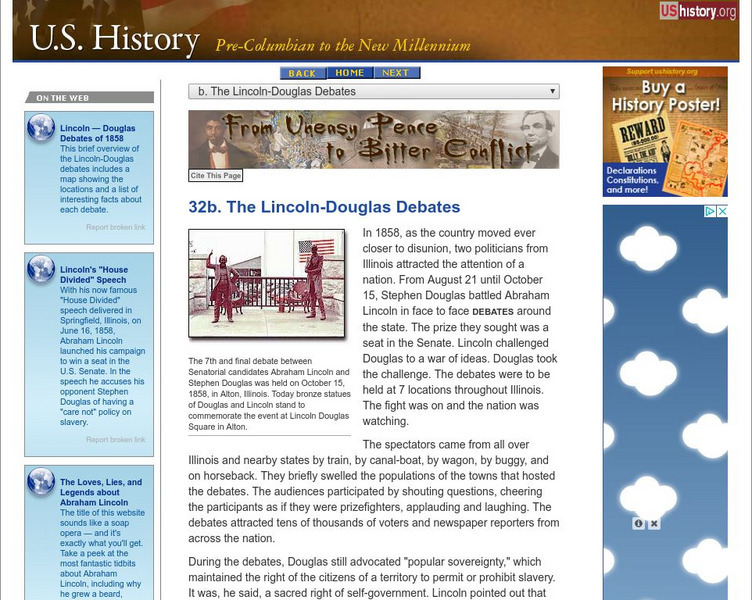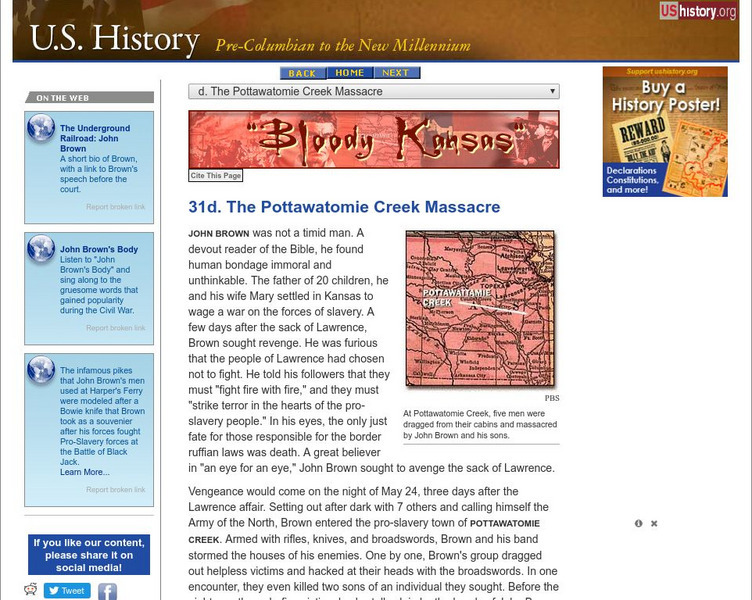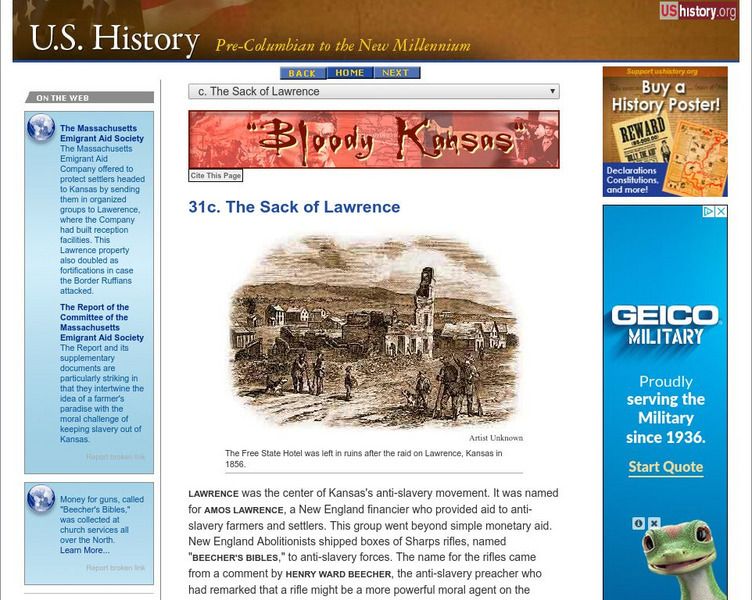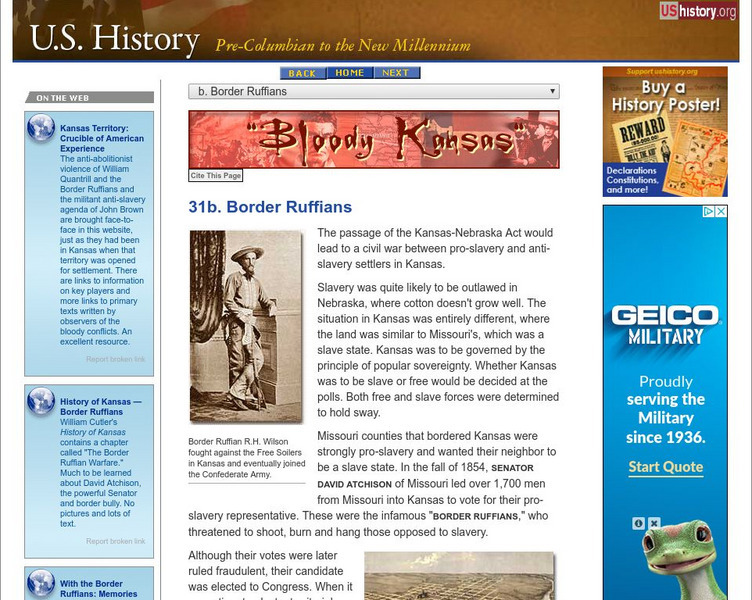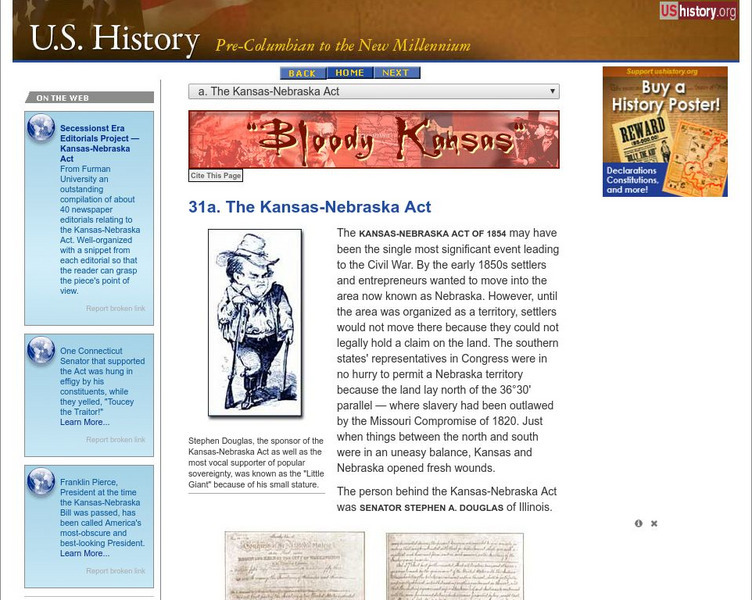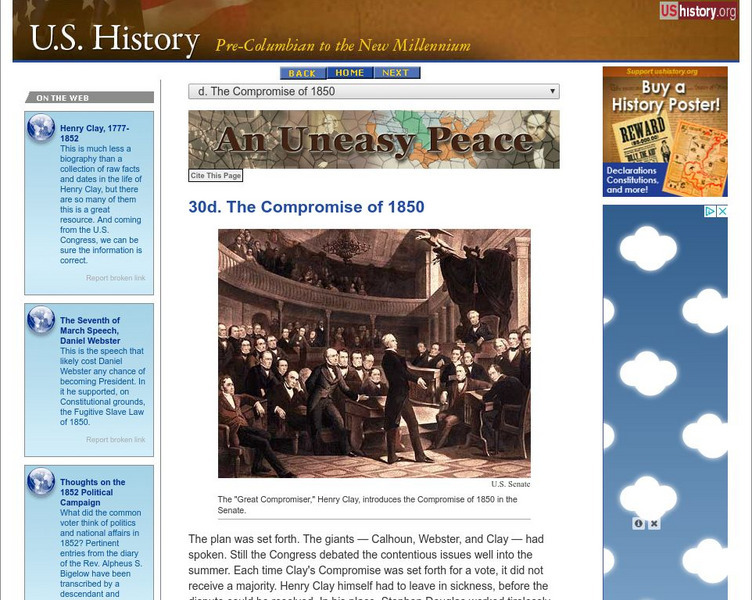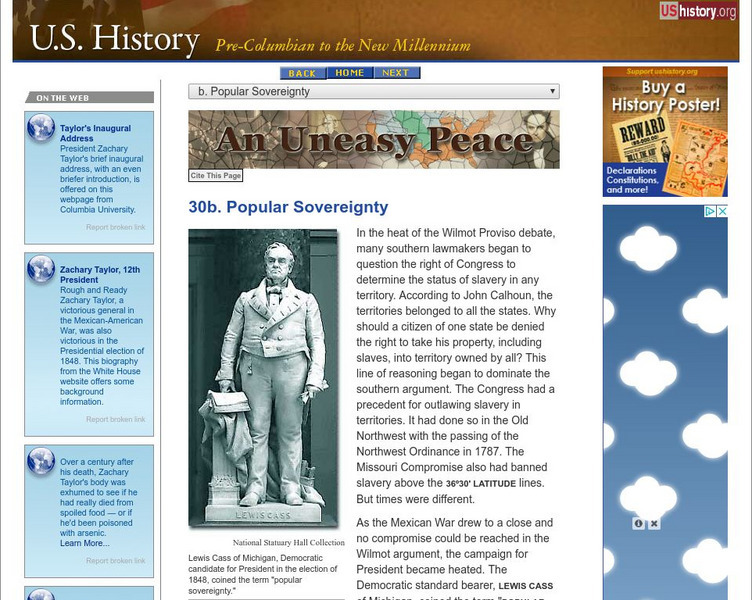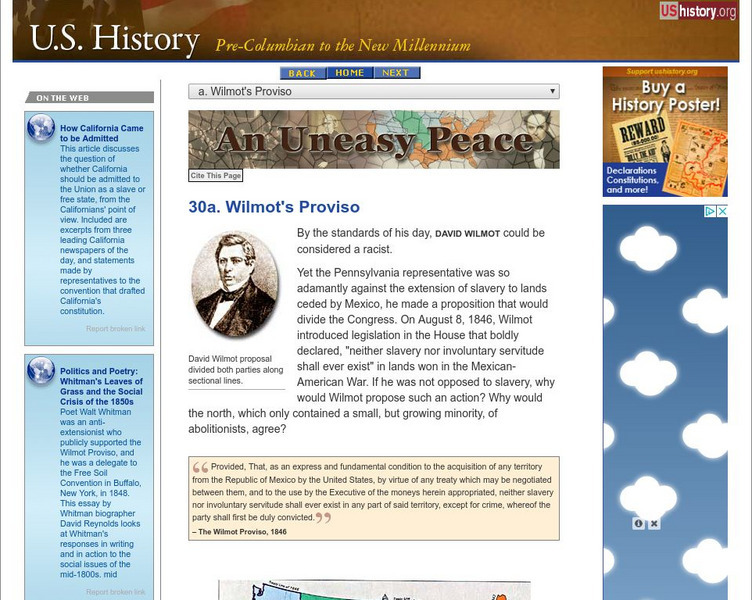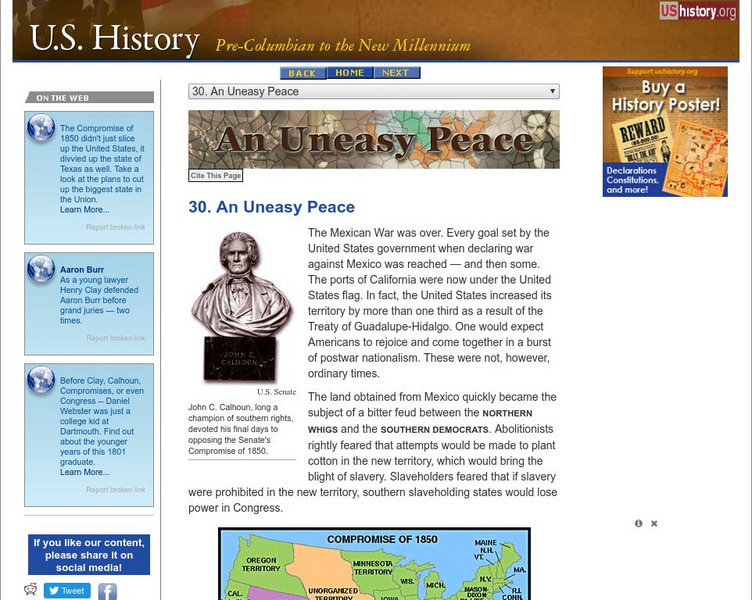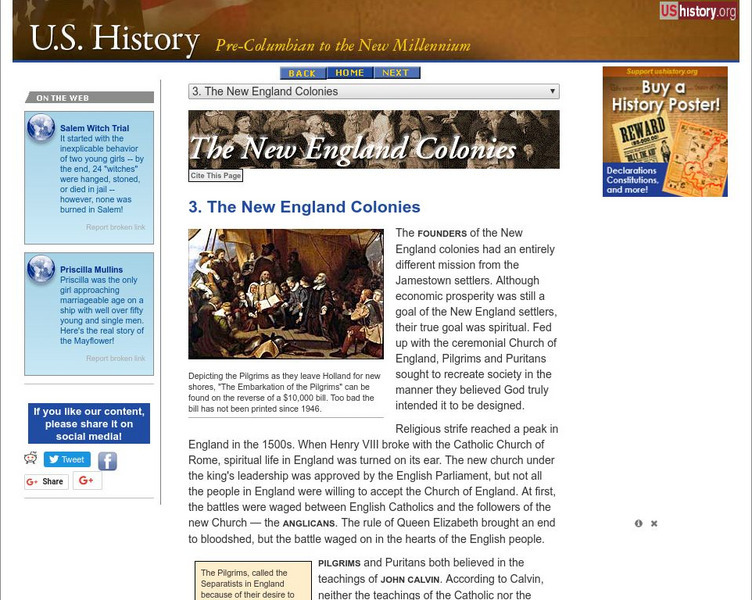Independence Hall Association
U.s. History: First Blood and Its Aftermath
Read about the first battle of the Civil War, the First Battle of Bull Run. Civilians were so enthralled with the prospect of watching a real battle, they traveled in droves south from Washington,D.C. Find out about the battle, how it...
Independence Hall Association
U.s. History: Strengths and Weaknesses: North vs. South
A very good compilation of the advantages and disadvantages of both the North and South at the beginning of the Civil War. The South had the trained officers, but the North had the factories to make rifles. Read about the major...
Independence Hall Association
U.s. History: Fort Sumter
A fascinating look at the "chess game" that involved Fort Sumter, a United States military installation in Charleston Harbor off the coast of South Carolina. Read about the moves by various leaders to keep or take the fort without...
Independence Hall Association
U.s. History: The Election of 1860
The election of Abraham Lincoln in 1860 was a watershed moment for the union of the country. Read about the political conventions, several candidates, and the votes that were split among them. Find a map that shows how the electoral...
Independence Hall Association
U.s. History: The Lincoln Douglas Debates
The Lincoln-Douglas debates in 1858 exemplified the rift in the nation concerning the issue of slavery and who should be able to determine whether states were free or slave. Read about this war of ideas that moved from the stage in...
Independence Hall Association
U.s. History: Canefight! Preston Brooks and Charles Sumner
Violence associated with strong feelings about slavery entered the halls of the Senate. Read what happened to Senator Charles Sumner after a two-day tirade he gave in the Senate after the sack of Lawrence, Kansas.
Independence Hall Association
U.s. History: The Pottawatomie Creek Massacre
John Brown, seeking revenge for the sack of Lawrence, Kansas, made Kansas even more bloody. Read about the Pottawatomie Massacre and its reverberations throughout Kansas.
Independence Hall Association
U.s. History: The Sack of Lawrence
Read about how the destruction of Lawrence, Kansas, seat of the Free-Soiler government by border ruffians inflamed attitudes in the North toward the actions of the slave-holders.
Independence Hall Association
U.s. History: Border Ruffians
Because of the terms of the Kansas-Nebraska Act, a election would be held to determine whether Kansas would be a slave or free state. Read about the fraudulent votes cast by the so-called border ruffians from Missouri, and see how Kansas...
Independence Hall Association
U.s. History: The Kansas Nebraska Act
Read about the essential repeal of the Missouri Compromise, which had established which states could be slave and which would be free for thirty years, with the rancorous passage of the Kansas-Nebraska Act. See who supported it and why,...
Independence Hall Association
U.s. History: "Bloody Kansas"
Here's an overview of the turmoil caused in the Kansas-Nebraska territory as a result of the Kansas-Nebraska Act. Read about the potential of conflict between the free-soilers and the border ruffians.
Independence Hall Association
U.s. History: The Compromise of 1850
Find the various parts of the Compromise of 1850, proposed by Henry Clay, that extended slavery in some cases, prohibited in others, and added California as a free state. A clear chart shows what parts of the law were beneficial to the...
Independence Hall Association
U.s. History: Popular Sovereignty
Read about the concept of popular sovereignty in relation to issue of expansion of slavery in the territories. It was not as simple as it seemed. Find out about how the issue of slavery was addressed in the election of 1848. Included is...
Independence Hall Association
U.s. History: Wilmot's Proviso
Congressman David Wilmot, even before the end of the Mexican-War, proposed legislation that would outlaw the expansion of slavery into the new territory, should the United States acquire it. Read about his reasons for proposing the...
Independence Hall Association
U.s. History: An Uneasy Peace
See what turmoil resulted from the acquisition of new territory after the Mexican-American War. There was great disagreement between those who wanted to abolish slavery and those who wanted to be able to carry slavery into the new lands....
Independence Hall Association
U.s. History: The New England Colonies
New England colonies and society were very different from the Jamestown and subsequent Southern colonies. Find out the reasons the colonists had for founding the New England colonies.
Independence Hall Association
U.s. History: Britain in the New World: War and Peace With Powhatan's People
Read about how Powhatan and his tribe initially helped the English settlers in Jamestown, but ultimately went to war. Find out about why the different views about land ownership exacerbated the tension between the two cultures.
Independence Hall Association
U.s. History: Britain in the New World: Jamestown Settlement
Jamestown, although not a financial sucess, was the first succesful English colony in North America. Find out how the colony was financed, what the first colonists hoped to find, how the colony was governed, and the hardships that were...
Independence Hall Association
U.s. History: Britain in the New World: Joint Stock Companies
A very good explanation of how early English settlements were financed, and why the English government refused to invest in such ventures. See who led such companies, who were willing to go to the New World, and why English colonies were...
Independence Hall Association
U.s. History: Gold in California
The gold rush in California accelerated the western migration of thousands of young American men, who streamed into California to find riches. See who else arrived in California and find out what they did. In addition, there is a map...
Independence Hall Association
U.s. History: The Lone Star Republic
Why did Mexico encourage settlement of Americans in Texas? Why did the Americans chafe under Mexican rule? Find out how this led to the Texas Revolution and the declaration of Texas as an independent country.
Independence Hall Association
U.s. History: Harriet Beecher Stowe Uncle Tom's Cabin
Harriet Beecher Stowe threw gas on the fire of the slavery issue with the publication of her novel, Uncle Tom's Cabin. Read about her background as an abolitionist, and find out the influence her book had in the North and even in Great...
Independence Hall Association
U.s. History: The Underground Railroad
A brief look at the Underground Railroad and how it operated. Find some of the code words used to help runaway slaves find their way, and read about some of the "conductors" who led slaves along the routes to the North.
Independence Hall Association
U.s. History: African American Abolitionists
Read about three African-American abolitionists who worked alone and in concert with white abolitionists. The most radical was David Walker, who was the founder of radical abolitionism.






